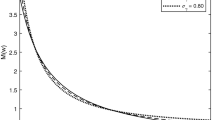Abstract
In this contribution, we evaluate European financial options under continuous cumulative prospect theory. In prospect theory, risk attitude and loss aversion are shaped via a value function, while a probability weighting function models probabilistic risk perception. We focus on investors’ probability risk attitudes, as probability weighting may be one of the possible causes of the differences between empirically observed options prices and theoretical prices obtained with the Black and Scholes formula. We consider alternative probability weighting functions; in particular, we adopt the constant relative sensitivity weighting function, whose parameters have a direct interpretation in terms of curvature and elevation. Curvature models optimism and pessimism when one moves from extreme probabilities, whereas elevation can be interpreted as a measure of relative optimism. We performed a variety of numerical experiments and studied the effects of these features on options prices and implied volatilities.






Similar content being viewed by others
Notes
Inspired by Allais’ paradox, the crucial idea underpinning rank dependent utility (RDEU) and cumulative prospect theory (CPT) models is that small probabilities (of a large gain or a large loss) do matter. According to Quiggin (1993) “the overweight of small probabilities should be applied only to low probability extreme outcomes, and not to low probability intermediate outcomes” (we are grateful to an anonymous referee for pointing out this).
The book of Wakker (2010) provides a thorough treatment on prospect theory.
See Quiggin (1993), p 56.
In the same paper Prelec derives two other probability weighting functions: the conditionally-invariantexponential-power and the projection-invarianthyperbolic-logarithm function.
This is not the case for weighting function (12); when \(a \ne b\), both parameters controls for curvature and all parameters may influence elevation.
This approach could be applied also for the evaluation of over-the-counter structured financial products and mortgages, when some option is embedded in the contract, and for the evaluation of options implicit in investment projects (real options).
Alternative dynamics could in principle be considered.
In other numerical trials we used alternative values of the parameters a, b and \(\lambda \); in particular \(20\,\%\) of the TK sentiment.
References
Allais M (1953) Le comportement de l’homme rationel devant le risque: critique des axioms et postulates de l’école Americaine. Econometrica 21(4):503–546
Allais M (1988) The general theory of random choices in relation to the invariant cardinal utility function and the specific probability function. The \((U, \theta )-\) model: a general overview. In: Munier BR (ed) Risk, decision and rationality. D. Reidel Publishing Company, Dordrecht, pp 231–289
Abbink K, Rockenbach B (2006) Option pricing by students and professional traders: a behavioral investigation. Manag Decis Econ 27(6):497–510
Abdellaoui M, L’Haridon O, Zank H (2010) Separating curvature and elevation: a parametric probability weighting function. J Risk Uncertain 41:39–65
Barberis N, Thaler RH (2003) A survey of behavioral finance. In: Constantinides GM, Harris M, Stulz R (eds) Handbook of the economics of finance. Elsevier Science, Amsterdam, pp 1051–1121
Bell DE (1985) Disappointment in decision making under uncertainty. Oper Res 33:1–27
Birnbaum MH, McIntosh WR (1996) Violations of branch independence in choices between gambles. Organ Behav Hum Decis Process 67:91–110
Black F, Scholes M (1973) The pricing of options and corporate liabilities. J Polit Econ 81(3):637–654
Breuer W, Perst A (2007) Retail banking and behavioral financial engineering: the case of structured products. J Bank Financ 31(3):827–844
Currim IS, Sarin RK (1989) Prospect versus utility. Manag Sci 35(1):22–41
Davies GB, Satchell SE (2007) The behavioural components of risk aversion. J Math Psychol 51(1):1–13
Diecidue E, Schmidt U, Zank H (2009) Parametric weighting functions. J Econ Theory 144(3):1102–1118
Goldstein WM, Einhorn HJ (1987) Expression theory and the preference reversal phenomena. Psychol Rev 94(2):236–254
Gonzalez R, Wu G (1999) On the shape of the probability weighting function. Cogn Psychol 38:129–166
Han B (2008) Investor sentiment and option prices. Rev Financ Stud 21(1):387–414
Heston SL (1993) A closed-form solution for options with stochastic volatility with applications to bond and currency options. Rev Financ Stud 6(2):327–343
Hey JD, Orme C (1994) Investigating generalizations of expected utility theory using experimental data. Econom 62(6):1291–1326
Hoffmann AOI, Fischer ET (2012) Behavioral aspects of covered call writing: an empirical investigation. J Behav Financ 13:66–79
Kahneman D, Tversky A (1979) Prospect theory: an analysis of decision under risk. Econometrica 47(2):263–292
Karmarkar US (1978) Subjectively weighted utility: a descriptive extension of the expected utility model. Organ Behav Hum Perform 21:61–72
Karmarkar US (1979) Subjectively weighted utility and the Allais Paradox. Organ Behav Hum Perform 24:67–72
Kilka M, Weber M (2001) What determines the shape of the probability weighting function under uncertainty? Manag Sci 47(12):1712–1726
Kothiyal A, Spinu V, Wakker PP (2011) Prospect theory for continuous distributions: a preference foundation. J Risk Uncertain 42:195–210
Lattimore PK, Baker JR, Witte AD (1992) The influence of probability on risky choice: a parametric examination. J Econ Behav Organ 17(3):377–400
Loomes G, Moffatt PG, Sugden R (2002) A microeconometric test of alternative stochastic theories of risk choise. J Risk Uncertain 24:103–130
Luce DR (2000) Utility of gains and losses: measurement-theoretical and experimental approaches. Lawrence Erlbaum Publishers, London
Luce DR (2001) Reduction invariance and Prelec’s weighting functions. J Math Psychol 45:167–179
Luce DR, Mellers BA, Chang SJ (1993) Is choice the correct primitive? On using certainty equivalents and reference levels to predict choices among gambles. J Risk Uncertain 6:115–143
Merton RC (1973) Theory of rational option pricing. Bell J Econ Manag 4:141–183
Nardon M, Pianca P (2014) A behavioural approach to the pricing of European options. In: Corazza M, Pizzi C (eds) Mathematical and statistical methods for actuarial sciences and finance. Springer, Berlin, pp 217–228
Pfiffelmann M (2011) Solving the St. Petersburg paradox in cumulative prospect theory: the right amount of probability weighting. Theory Dec 75:325–341
Polkovnichenko V, Zhao F (2013) Probability weighting functions implied in options prices. J Financ Econ 107:580–609
Poteshman AM, Serbin V (2003) Clearly irrational financial market behavior: evidence from the early exercise of exchange traded stock options. J Financ 58(1):37–70
Prelec D (1998) The probability weighting function. Econom 66(3):497–527
Quiggin J (1982) A theory of anticipated utility. J Econ Behav Organ 3:323–343
Quiggin J (1993) Generalized expected utility theory: the rank-dependent model. Springer, Netherlands
Rieger MO, Wang M (2006) Cumulative prospect theory and the St Petrsburg paradox. J Econ Theory 28:665–679
Rieger MO, Wang M (2008) Prospect theory for continuous distributions. J Risk Uncertain 36:83–102
Röell A (1987) Risk aversion in Quiggin and Yaari’s rank-order model of choice under uncertainty. Econ J 97:143–159
Safra Z, Segal U (1998) Constant risk aversion. J Econ Theory 83:19–42
Schmeidler D (1989) Subjective probability and expected utility without additivity. Econometrica 57:571–587
Schoutens W (2003) Lévy processes in finance: pricing financial derivatives. Wiley, Chichester
Shefrin H, Statman M (1993) Behavioral aspects of the design and marketing of financial products. Financ Manag 22(2):123–134
Shiller RJ (1999) Human behavior and the efficiency of the financial system. In: Taylor JB, Woodford M (eds) Handbook of macroeconomics. Elsevier, Amsterdam, pp 1305–1340
Subrahmanyam A (2007) Behavioural finance: a review and synthesis. Eur Financ Manag 14(1):12–29
Thaler RH (1985) Mental accounting and consumer choice. Mark Sci 4:199–214
Thaler RH (1999) Mental accounting matters. J Behav Decis Mak 12:183–206
Tversky A, Fox CR (1995) Weighting risk and uncertainty. Psychol Rev 102:269–283
Tversky A, Kahneman D (1992) Advances in prospect theory: cumulative representation of the uncertainty. J Risk Uncertain 5:297–323
Versluis C, Lehnert T, Wolff CCP (2010) A cumulative prospect theory approach to option pricing. Working paper, LSF Research Working Paper Series 09–03, Luxembourg School of Finance
Wakker PP (2010) Prospect theory: for risk and ambiguity. Cambridge University Press, Cambridge
Walther H (2003) Normal randomness expected utility, time preferences and emotional distortions. J Econ Behav Organ 52:253–266
Wu G, Gonzalez R (1996) Curvature of the probability weighting function. Manag Sci 42(12):1676–1690
Wu G, Gonzalez R (1999) Nonlinear decision weights in choice under uncertainty. Manag Sci 45(1):74–85
Yaari M (1987) The dual theory of choice under risk. Econometrica 55(1):95–115
Author information
Authors and Affiliations
Corresponding author
Rights and permissions
About this article
Cite this article
Nardon, M., Pianca, P. European option pricing under cumulative prospect theory with constant relative sensitivity probability weighting functions. Comput Manag Sci 16, 249–274 (2019). https://doi.org/10.1007/s10287-018-0324-y
Received:
Accepted:
Published:
Issue Date:
DOI: https://doi.org/10.1007/s10287-018-0324-y




